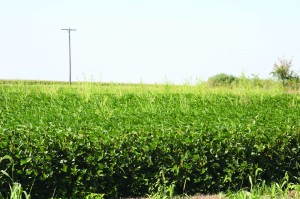The Next Steps In Weed Control
For anyone who pays attention to the news, the spread of herbicide-resistant weeds in agricultural fields is quickly becoming a pandemic of sorts. To appreciate this fact, consider just a few of the numbers to come out at the recent 53rd meeting of the Weed Science Society of America (WSSA/67th meeting of the Northeastern Weed Science Society (NWSS):
In America during 2012, it is estimated by researchers that more than 60 million acres of farmland were invested with herbicide-resistant weeds. “I’ve been through the Mid-South and it is not uncommon to see whole cotton fields filled with Palmer amaranth,” said Jason Norsworthy, associate professor, department of crop, soil and environmental sciences, the University of Arkansas, at the meeting.
Of those weeds that have a single form of herbicide resistance, 30% usually develop multiple resistance. For weeds with glyphosate resistance, this figure grows to 62%.
Globally, herbicide resistance has evolved for all modes of action in 208 weed species represented by 382 weed biotypes — and this figure keeps growing on an almost daily basis.
In 2013, herbicide-resistant Palmer amaranth could cost Tennessee soybean growers more than $200 million in herbicide/application costs and crop yield loss.
A single herbicide-resistant weed can have a significant impact on crop yields. For example, research has shown that just one giant ragweed plant per square meter can reduce crop yields between 45% and 77%. “More food is lost due to weeds than all other pest complexes combined,” said Dr. Michael Owen, Extension weed specialist and professor of agronomy, Iowa State University.
With these numbers in mind, perhaps Mark Peterson, global biology leader for Enlist at Dow AgroSciences, said it best at the meeting: “Resistant weeds represent a significant challenge to global agricultural production at a time of unprecedented demand.”
How We Got Here
Some in the agricultural industry might be wondering how today’s widespread infestation of resistant weeds came about, but according to Jodie Holt, professor of plant physiology at the University of California-Riverside, resistance is universal. “The evolution of weed resistance will occur no matter what control methods are being used,” said Holt.
Furthermore, according to Harold Coble, agronomist for USDA, it is unfair for critics to blame the herbicides themselves for creating resistant weeds. “Many people in agriculture want to blame the technology, but it is not the technology’s fault,” said Coble. “If anything, maybe it was too good when using it. Up until now, the main focus has been on killing weeds with the weed control being chemically-based. Herbicide-tolerant crops allowed growers to grow more acres and spend less time on weed control.”
Still, there were some at the meeting that did see the widespread use of glyphosate-resistant crops as at least part of the reason for today’s host of herbicide-resistant weeds. For instance, back in the 1970s, it wasn’t usually for growers to have to use four or five different herbicides to control weeds in their fields. Then along came glyphosate. Now, instead of applying multiple products per season, a single application of glyphosate could provide widespread weed control. As Bryan Young, professor, department of plant, soil and agricultural systems, Southern Illinois University (SIU), put it: “What happened with Roundup Ready crops is that they made everyone an excellent applicator.”
However, as glyphosate use expanded, conditions were ripe for quickly adaptive weeds to begin appearing. “There were 154 million acres of genetically-modified crops planted in 2012,” said Dr. David Mortensen, researcher at Penn State University. “Nothing is rare across that many acres when it comes to weeds.”
In addition, said SIU’s Young, this situation has been further complicated by efforts to address spray drift. “The desire to reduce glyphosate drift has probably led to more resistance because applicators aren’t using the product at its prescribed rates,” he said. “This has given survivor weeds the opportunity to adapt more quickly.”
Instead, many at the meeting placed the blame at the grower’s feet. “I have a grower friend who asked me recently ‘how did you let us get into this mess?’, referring to the resistant weed problem,” said USDA’s Coble. “I quoted back to him that famous Pogo cartoon strip: ‘We have met the enemy, and he is us.’”
According to Coble, many growers have tended to focus on their weed issues “one year at a time.” In these instances, having marginal weed control “will help pay the bills for that season,” without considering how missed weeds might evolve into resistant ones during the next crop season.
In other instances, growers tend to have an attitude that herbicide-resistant weeds “could not be avoided,” so they do nothing to address them in the long-term.
“Maybe resistance is unavoidable, but growers could have managed it better,” said Coble. “Weed control is not rocket science — it’s harder because it isn’t based solely on numbers and keeps changing all the time.”
Making this problem even worse, said Amy Asmus, co-owner of Asmus Farm Supply, Rake, IA, is what could be called “The Neighbor Effect.” In essence, growers who have neighbors with resistant weeds problems tend to view any control methods on their parts as futile. “In a survey I conducted of growers, only 40% of them said they implemented weed resistance best management practices when resistant weeds showed up in their fields,” said Asmus.
New Practices Needed
When it comes to these best management practices for weed control, virtually everyone at the meeting agreed that the days of simply controlling fully-developed weeds and sprouts “are at an end.” Instead, agriculture needs to adopt a “zero tolerance” approach to weed control and target the entire weed life cycle. “We are losing herbicides in agriculture at an alarming rate,” said the University of Arkansas’ Norsworthy.
According to Norsworthy, there are 11 best management practices that should be followed to keep the herbicide-resistant problem from spreading faster than it already is. These include:
- Understanding the biology of the weeds already present in the field.
- Using a diversified approach to weed management that focuses on preventing seed production and reducing the seed bank already in the soil.
- Using an effective burndown strategy for growers who are planting in weed-free fields.
- Planting weed-free crop seed.
- Scouting fields regularly during the season to keep an eye out for weeds that might have survived early-season application work.
- Using multiple modes of action herbicides that are effective against the most troublesome weeds.
- Applying herbicides at the recommended label rates and for the recommended weed sizes.
- Using mechanical weed control methods along with biological ones when it is appropriate to do so.
- Prevent field-to-field movement of weed seed by cleaning equipment before it moves out of a particular patch of land.
- Manage weed seed spread at harvest time.
- Prevent an influx of weed seed by monitoring field borders (where potential resistant weeds might have been missed during any in-season application work).
“These best management practices will vary by crop, region and the types of weeds involved,” said Norsworthy. “However, if these are followed, they should provide an effective way to prevent the spread of resistant weeds.”
As USDA’s Coble noted, many of these best management practices seem common sense and involve simply paying attention. And, he added, that may be exactly what’s needed to keep resistant weeds from spreading.
“If we can get growers to do a better job of monitoring their fields for weeds, we could curb some of these problems,” said Coble.
What’s Ahead
Besides these best management practices, there are a few other new weapons ready to enter the fight against herbicide-resistant weeds. For example, in the next year or so, crops with tolerances for dicamba and 2,4-D should be entering the marketplace. One such product line is the Enlist system from Dow AgroSciences. According to the company’s Peterson, research has shown that using Enlist Duo herbicide with Colex-D technology can provide 95% control of several key weed species with glyphosate-resistance.
“Herbicides have been shown to be a key part of efficient, sustainable weed management systems that maximize production while preserving soil and water resources,” said Peterson. “It is important to note that herbicide-tolerant crops have enabled great advances in soil conservation and carbon sequestration — having growers go back to widespread tillage to control weeds will negate those environmental advantages. New technologies such as Enlist will enable more modes of action, increasing weed management diversity and sustainability.”
Also in the pipeline is BioDirect technology from The Monsanto Co. According to Dr. John Soteres, scientific affairs, weed resistance management lead for the company, BioDirect is based upon interfering with the RNA of a weed, which can ultimately kill it. “BioDirect can be applied via spray equipment and be used in conjunction with glyphosate and other herbicides for weed control,” said Soteres. “This method was introduced in April 2012 and is now in its Phase II testing.”
Despite these new products/systems coming down the line, a few speakers at the WSSA/NWSS meeting were less than enthusiastic about their introductions. “These new systems will neither help nor hinder the spread of resistant weeds,” said Stephen Duke, researcher for USDA. “These are more tools that will be available to growers to fight weeds, but they will have to have the will to use them. These won’t be widespread answers to the question of herbicide-resistant weeds, but they will offer some new options for growers to consider.”
To achieve this kind of widespread answer to the question of weed resistance, perhaps ag retailer Asmus offered the best advice. “Those that advise growers on how to control their weed problems need to be knowledgeable about all the ways to do this, not just repeat the same marketing programs we’ve used in the past,” she said. “As an industry, we need to stop trying to change the way growers have traditionally managed their weeds and offer them short-term solutions to gain control of the situation. Then, we need to provide them with a more long-term solution to maintain that control.”







